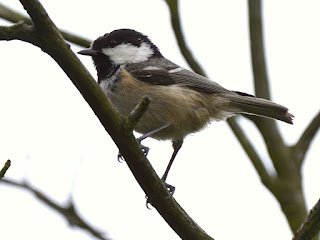Goldcrests are nesting in a yew tree by the bridge. The nest is hard to see, since you have to look up against the light, but I got some kind of a photograph.
It looks quite like a Long-Tailed Tits' nest, but is a different shape -- a deep cup. Goldcrests have a lot of chicks, as many as 18. These climb to the top of the nest to be fed and go down afterwards, so that there is a constant circulation. They have to be fed at least every 20 minutes, keeping both parents constantly busy catching insects.
Ahmet Amerikali got a shot of one of the parents arriving with an insect.
The Long-Tailed Tits in the Rose Garden pergola were still busy building their nest.
A female Great Tit by the Henry Moore sculpture begged her mate to feed her, to ensure that he would look after her when she was nesting. He did turn up in the end.
The Coal Tit was waiting by Mount Gate for its daily treat of pine nuts. Their preferred habitat is the Stone Pine (Pinus pinea) which is the species that produces these seeds, and the Coal Tits peck them out of the cones.
A Blackbird sang in a lime tree beside the leaf yard, pausing occasionally to preen.
His mate was on the ground listening to him.
One of the Jackdaws at the leaf yard tore up a bit of cloth to make fluff to line its nest hole.
There was a handsome tricoloured Feral Pigeon on the edge of the Serpentine.
Today, for the first time, the Grey Heron chicks in the nest at the east end of the island put their little punky heads above the edge of the nest. You could see two.
The nine Coot chicks in the Italian Garden fountain kept one of their parents frantically occupied feeding them, while the other was preening and not helping. Occasionally one of the most pushy chicks had to be chased off to give the others a chance.
The male Mute Swan at the Serpentine outflow guarded the nest. The female isn't sitting yet.
An Egyptian Goose on the south shore had nine goslings. They are several days old and it was surprising not to have seen them before.
One of them is blond.
There was also a pair with three, luckily far enough up the shore for them not to attack each other.
The single gosling at the Lido was still all right. It always seems to be on the jetty now rather than feeding on the grass. It may be able to get insects off the rubber non-slip mat, but really you need a sharp beak like a Pied Wagtail's to get them out of the grooves.
The Mallard ducklings are down to five. Their mother was being harassed by four drakes. Their violent lust increases the losses of young when their mother has to flee, so it's working against the survival of the species.
The Mandarin drake was alone again at the Lido. It does seem that the pair are busy nesting.
The trees along the west edge of the West Carriage Drive between the Serpentine Gallery and Mount Gate are Indian Horse Chestnuts (Aesculus indica). Their new leaf shoots are an attractive deep red.
This tree is increasingly planted as it's not affected by the leaf miner moth that is attacking the ordinary Horse Chestnut (A. hippocastanum). It was first brought to Britain in the 1850s, later than the ordinary one native to eastern Europe which arrived in the late 16th century. The Sweet Chestnut (Castanea sativa) is thought to have been introduced by the Romans.

%202024%201a.jpg)












The single Egyptian gosling was at the waters edge when the lido area was busy with swimmers. The jetty seems to a relatively safe place for them later, with one parent on guard near where people and dogs would walk onto it, the gosling rests further along near its other parent, as you've photographed.
ReplyDeleteGreat that you've found two other Egyptian pairs with goslings.
I'm afraid the two other Egyptian families won't last long, but (with fingers crossed and touching wood madly) I'm beginning to have modest hopes for the gosling at the Lido.
DeleteHubby was listening to the Blackbird video and said the bird sings differently from ours. I think he has a point - regional/national dialects in birds are a thing!
ReplyDeleteFinding a Goldcrest nest must be nothing short of miraculous.
Tinúviel
No doubt Blackbirds do have regional dialects, though it would take attentive listening to Xeno-canto to establish that. But Blackbirds work up their own songs and there is also considerable difference between individuals.
DeleteGoldcrests nest in that yew tree every year, but in a different place so the nest has to be found, very small and well camouflaged in a big tree. It was Ahmet who found it.
Hope your Goldcrest is successful & not discovered by eagle-eyed Jays or Magpies.
ReplyDeleteA very attractive Feral Pigeon for sure.
I do think Indian Horse Chestnuts are a very stately tree. There's an avenue of them at Kew near the entrance by the green.
So far the Goldcrests in that yew have bred successfully every year. The nest is well placed under a branch and it would be hard for a corvid to raid it. Fingers crossed.
DeleteGood to hear. I was pleased to record a pair on my BBS square this morning- bird so easy to overlook.
ReplyDeleteThere are six singing males on my normal route through the park, and no doubt others elsewhere. Of course this is the time when you notice them most.
Delete